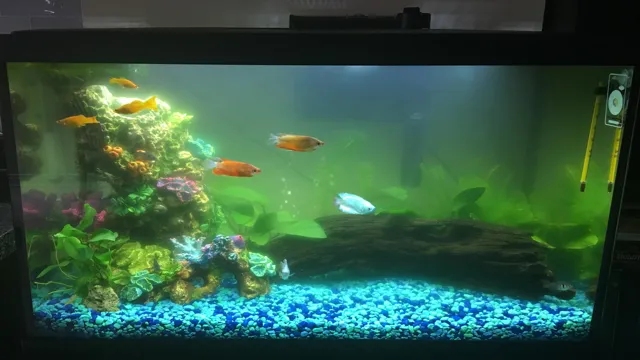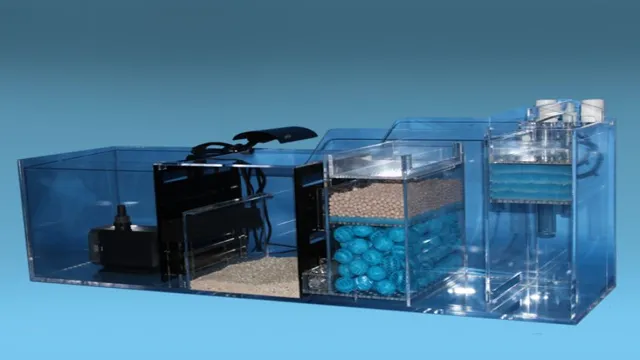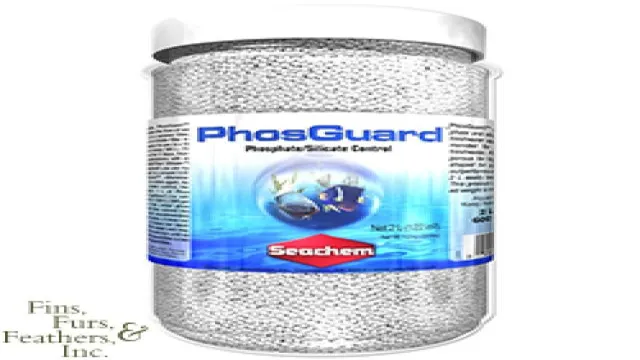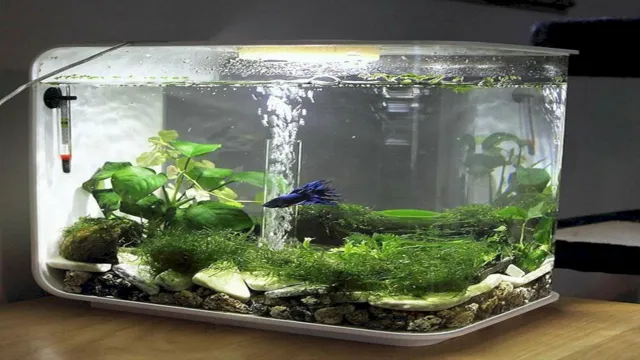How to Get Rid of Green Cloudy Aquarium Water: Tips and Tricks

Do you own an aquarium and struggle with green, cloudy water? It can be frustrating when you’re trying to admire your fish but all you can see is an unappealing green haze. However, don’t worry, because there are ways to get rid of that unsightly cloudiness. First, it’s important to understand what causes green, cloudy water in the first place.
In most cases, it’s due to an overgrowth of algae. Algae thrive in environments where there’s an abundance of nutrients and sunlight. Poor water conditions and overfeeding can contribute to the problem.
One of the easiest ways to combat green water is by performing regular water changes. This helps remove excess nutrients and keeps the water fresh and clean. You can also add live plants to help absorb nutrients and prevent algae growth.
Another solution is to invest in a UV sterilizer, which uses ultraviolet light to kill off algae and other microorganisms. While it may be a more expensive option, it can be highly effective in maintaining clear water. In conclusion, don’t lose hope if you’re dealing with green, cloudy water in your aquarium.
By implementing some simple solutions, you can restore the clarity and beauty of your tank. With a little effort and commitment, you can enjoy your fish in a crystal clear environment.
Causes of Green Cloudy Water
If you’re seeing green cloudy water in your aquarium, don’t worry, you’re not alone. This is a common problem that can be caused by a variety of factors. One potential culprit is excess nutrients in the water, such as nitrates and phosphates.
These nutrients can feed algae, which can quickly turn your water green and cloudy. Another possible cause is inadequate filtration, which can cause debris and waste to build up in the water and lead to algae growth. Finally, excessive exposure to sunlight can also fuel algae growth.
Fortunately, there are several things you can do to get rid of green cloudy water. First, consider investing in a high-quality filter and increasing water changes to reduce nutrient levels. You can also use aquarium-safe medications and algae-eating fish to help combat excess algae growth.
And remember, prevention is key – regular water changes, proper maintenance, and reduced sunlight exposure can all help keep your water clean and clear.
Algae Blooms
Green Cloudy Water Algae blooms are a common issue for many pond and lake owners, causing the water to turn green and cloudy. There are a few main factors that contribute to these blooms. One of the biggest causes is nutrient overload, which occurs when there is an excess of nutrients, such as nitrogen and phosphorus, in the water.
These nutrients can come from a variety of sources, including fertilizer runoff from nearby agricultural fields, wastewater treatment plants, and even pet waste. Another contributing factor is warm temperatures, which encourage the growth of algae. In the summer months, the water in ponds and lakes can become quite warm, providing the perfect conditions for algae to thrive.
This is why you are more likely to see algae blooms during the summer than in cooler months. Finally, low water flow can also contribute to algae blooms. If there is not enough movement in the water, it can become stagnant and provide an ideal breeding ground for algae.
This is why ponds and lakes with poor circulation or that are shallow are more likely to experience algae blooms. To combat green, cloudy water caused by algae blooms, it’s important to reduce nutrient overload. This can be done by reducing the use of fertilizers near bodies of water and ensuring that pet waste is disposed of correctly.
It’s also essential to maintain proper water flow by using aeration systems or adding water features, such as fountains or waterfalls, to keep the water moving. By taking these steps, you can help to prevent algae blooms and maintain healthy, clear water in your pond or lake.

Overfeeding Fish
Overfeeding fish can lead to a variety of problems, including green cloudy water in your aquarium. This occurs when there is an excess of nutrients in the water, causing an overgrowth of algae. Fish food, just like any other type of food, contains nutrients that are essential for your fish to grow and maintain good health.
However, when too much food is given, the fish are unable to consume it all, leading to leftover food which then becomes a source of excess nutrients in the water. This abundance of nutrients, coupled with the warmth and light in your aquarium, creates the perfect breeding ground for algae. To prevent green cloudy water, it is important to feed your fish only what they need and to remove any uneaten food from the water.
This will help to maintain the perfect balance of nutrients in the water, keeping it crystal clear for your fish to enjoy.
Poor Filtration or Insufficient Water Changes
Green cloudy water in aquariums can be caused by poor filtration or insufficient water changes. When the filter system is not working effectively, it cannot remove the waste products that the fish produce. These waste products can build up and create a cloudy appearance.
Additionally, if the aquarium owner is not performing enough water changes, the water quality can also deteriorate and lead to cloudy conditions. It’s best to establish a regular maintenance schedule to ensure that the filtration system and water changes are consistently performed. Not only will this prevent green cloudy water, but it will promote a healthy environment for the fish and plants in the aquarium.
Remember, neglecting the maintenance of an aquarium can have serious consequences for the aquatic life living within it. So, give your aquarium all the care and attention it deserves for optimal conditions, including regular filtration maintenance and water changes.
Testing and Monitoring Water Conditions
Are you tired of looking at the green, cloudy water in your aquarium? Maintaining the water conditions in your aquarium is important not only for the aesthetic appearance but also for the health and wellbeing of your fish. One way to get rid of cloudiness in your aquarium water is to test it regularly for pH levels, ammonia, nitrate, and nitrite levels. This will help you understand what is causing the cloudiness and make necessary adjustments.
Additionally, monitoring the temperature and ensuring proper filtration can also help prevent cloudy water. If you have already tested and adjusted your water conditions and still have cloudy water, try using a UV sterilizer or adding activated carbon to your filter to help clear the water. Remember, consistency and monitoring are key to maintaining a healthy and clean aquarium environment for your fish to thrive in.
Test for High Nutrient Levels
In order to maintain a healthy aquatic environment, it’s important to regularly test the nutrient levels in the water. High nutrient levels can lead to a number of issues, including harmful algae blooms and fish kills. There are a few different types of nutrients to test for, including nitrogen, phosphorus, and carbon.
Nitrogen and phosphorus are often found in fertilizers and can come from runoff from farms or lawns. Carbon, on the other hand, can come from decaying organic matter. Regular monitoring of nutrient levels can help prevent these issues and ensure that the water remains a safe and healthy environment for all aquatic life.
It’s important to use accurate testing methods and to take action if nutrient levels are found to be too high. By keeping a close eye on nutrient levels, we can help protect our waterways and maintain a thriving aquatic ecosystem.
Monitor Water Temperature
When it comes to maintaining the quality of your aquarium or aquatic ecosystem, the temperature of the water plays a crucial role. For aquatic animals, the right water temperature is essential for their health and survival. That is why regular monitoring and testing of water conditions is essential.
By monitoring the water temperature, you ensure that it stays within the recommended range for the specific species you have. The temperature requirements of fish and plants can vary greatly depending on their origins. For instance, if you have tropical fish, they require warmer water temperatures than cold water fish.
So, it’s necessary to have adequate knowledge of the aquatic species that are part of your ecosystem and the temperature levels they require. By keeping the right water temperature, you can prevent illnesses and promote healthier growth for your aquatic creatures. Overall, monitoring the temperature of your aquarium or aquatic ecosystem is essential to maintaining a thriving environment for your aquatic animals.
Adjust Water Parameters
If you have green cloudy water in your aquarium, adjusting the water parameters can be an effective solution. Start by testing the pH, ammonia, nitrate, and nitrite levels in your tank to identify any imbalances. High levels of these parameters can contribute to the growth of algae, leading to cloudy water.
Consider doing a partial water change and adding in a freshwater conditioner to help neutralize any harmful chemicals or contaminants in the water. Adding in live plants or utilizing a UV sterilizer can also help to combat algae growth and improve water clarity. Remember to monitor your tank regularly and adjust the parameters accordingly to maintain a healthy environment for your fish and plants.
With some patience and persistence, you can say goodbye to that unsightly green cloudiness in your aquarium.
Reduce Light Exposure
If you’re experiencing problems with your aquarium plants, the issue might be due to improper lighting. While plants need light to photosynthesize and grow, too much or too little light can cause problems. Excessive light exposure can lead to algae growth, while insufficient light can cause slow plant growth and even death.
To avoid these issues, it’s essential to regulate the amount of light your aquarium plants receive. One way to do this is by using a timer to regulate the length of time your aquarium lights are on. You can also reduce light exposure by moving your aquarium plants away from direct sunlight or installing a light diffuser to soften the intensity of the light.
By properly regulating light exposure, you can help your aquarium plants thrive and avoid common problems associated with excessive or insufficient light.
Reduce Feeding Amounts
Reducing feeding amounts is an essential step in maintaining a healthy and harmonious aquarium ecosystem. Overfeeding can cause excess nutrients to accumulate in the water, leading to algae blooms and harmful bacteria growth. To prevent this, it’s best to observe your fish and adjust feeding amounts accordingly.
As a general rule, it’s better to underfeed than overfeed. You can also try feeding your fish smaller amounts multiple times a day to prevent uneaten food from accumulating at the bottom of the tank. Additionally, regularly testing and adjusting water parameters, such as pH and ammonia, can help ensure a healthy environment for your aquatic pets.
By taking these precautions and being mindful of your fish’s feeding habits, you can maintain a clean and thriving aquarium.
Add Live Plants or Algae Eaters
Having live plants in your aquarium not only adds a natural aesthetic to your underwater world but also helps maintain a healthy environment for your fish. Live plants release oxygen and absorb harmful chemicals, such as nitrates and phosphates, which in turn helps keep the water clean and clear. Additionally, certain species of algae eaters, such as snails and shrimp, can aid in keeping algal growth under control.
In order to fully optimize the benefits of live plants and algae eaters, it’s important to adjust and maintain proper water parameters, such as temperature, pH, and water hardness. These parameters vary depending on the species of plants and fish in your aquarium, so it’s important to conduct research and consult with a professional to find the best balance for your aquatic ecosystem. By adding live plants and algae eaters and adjusting the water parameters accordingly, you’ll not only have a beautiful aquarium but also provide a healthy and happy home for your underwater friends.
Clean and Maintain Aquarium Equipment
If you’re struggling with green and cloudy water in your aquarium, it’s time to take a look at your equipment. Firstly, make sure you’re not overfeeding your fish. Overfeeding can cause excess waste, which can lead to algae growth.
Check your filter and make sure it’s working properly. If it needs replacing, do so immediately. Another key way to combat green water is by performing regular water changes.
Aim for a 25% water change every two weeks to keep the water in tip-top condition. You should also clean your aquarium decorations and substrate regularly to remove any built-up waste or debris. Finally, invest in a good quality algae scraper or magnet cleaner to keep the glass and walls of the aquarium free from algae.
By following these simple steps, you should be able to say goodbye to green, cloudy water and hello to a beautifully clear and healthy aquarium.
Regular Water Changes and Gravel Vacuuming
One of the most essential aspects of maintaining a healthy aquarium is performing regular water changes and gravel vacuuming. These two tasks work hand in hand to aid in the removal of harmful debris, uneaten food, and waste particles from the aquarium water. Properly cleaning the aquarium equipment doesn’t just help keep the water crystal clear, but it also helps to reduce the levels of harmful chemicals in the water which can be dangerous to aquatic life.
A general rule of thumb for water changes is to aim for at least 25% to 50% of the total water volume to be replaced every two weeks. The frequency and amount of water changes will depend on the size and stocking levels of the aquarium. Gravel vacuuming is also crucial as it helps to remove uneaten food and any other debris that may have collected on the gravel bed.
Make sure to vacuum only a small area at a time to avoid disturbing the beneficial bacteria colonies living in the gravel. By carrying out these regular maintenance tasks, you can ensure that your aquarium remains a healthy and thriving environment for your aquatic pets.
Clean Filter and Replace Media
If you’re a newcomer to the world of aquariums, one of the most essential things to learn is how to keep your equipment well-maintained. Keeping your aquarium clean and healthy should be your top priority because the animals inside the tank rely entirely on you to maintain their environment. Regularly cleaning your filter and replacing the media will ensure that your tank remains clear and healthy.
Cleaning the filter regularly will increase its lifespan and reduce clogging, and you’ll notice that your water quality will improve significantly. With time, the media in your filter will also wear out, which is a key reason for cleaning it. Suppose your aquarium’s filter media is becoming too dirty, replace it with fresh media, ensuring that the new media has the right composition to promote bacterial growth and keep your tank healthy.
By ensuring the filter is cleaned and the media replaced when necessary, you can maintain a healthy living environment for your aquarium inhabitants.
Ensure Proper Aeration and Water Flow
When it comes to maintaining a healthy aquarium, ensuring proper aeration and water flow are crucial. This means keeping all of your aquarium equipment, such as filters and air pumps, clean and maintained. Regular cleaning and maintenance of your aquarium equipment help to prevent blockages that can hinder water flow and lead to poor oxygenation in your aquarium.
Additionally, dirty or clogged equipment can harbor harmful bacteria that can negatively impact the overall health of your fish and aquatic plants. By taking the time to clean and maintain your aquarium equipment, you can ensure that your aquarium has the proper water flow and aeration needed to thrive. So, don’t neglect this essential aspect of aquarium maintenance and keep your aquatic pets happy and healthy with clean, well-maintained aquarium equipment.
Preventing Green Cloudy Water
Are you tired of dealing with green cloudy water in your aquarium? It’s not only unsightly but also harmful to your fish. The good news is that there are several ways to prevent this from happening and get rid of it if you’ve already got it. Firstly, make sure you’re not overfeeding your fish and that you’re doing regular water changes.
Excess nutrients from leftover food and waste can be a major contributor to green water. Secondly, ensure that your aquarium is not receiving too much light. Algae require light to thrive, so limiting the amount they receive can help prevent it from growing out of control.
You can try reducing the amount of time your aquarium light is on or investing in a timer to control the duration of light exposure. Lastly, consider introducing live plants to your aquarium. Live plants are great at removing excess nutrients from the water and can help prevent algae growth.
By following these simple steps, you can prevent and get rid of green cloudy water in your aquarium for a healthier and more beautiful environment for your fish.
Establish a Regular Maintenance Routine
If you’re looking to prevent green cloudy water in your aquarium, establishing a regular maintenance routine is crucial. Neglecting your aquarium can lead to an overgrowth of algae and bacteria, which can cause water discoloration and even harm your fish. To prevent this, consider performing routine water changes and cleaning your filtration system.
For instance, you can remove any debris such as uneaten food or dead plants and rinse the filter media. Additionally, you may want to invest in a good quality water-testing kit to monitor the water quality in your aquarium. By incorporating these maintenance practices into your routine, you can keep your aquarium clean and clear while also ensuring a healthy environment for your aquatic pets.
Remember, prevention is always better than cure.
Avoid Overstocking Your Aquarium
Overstocking your aquarium is a common mistake that can lead to all sorts of algae and water problems, including green cloudy water. To prevent this, you need to be mindful of the number and size of fish you add to your tank. It’s easy to get carried away when adding new fish, but doing so can quickly upset the balance of your aquarium.
If you overload your aquarium, then the biological filter may not be able to keep up with the waste produced by your fish. As a result, this can lead to an increase in ammonia and nitrite levels, which can be harmful to aquatic life. So, make sure to research each species you plan to add and how they will affect your tank’s ecosystem.
Remember, a crowded aquarium isn’t good for your fish and can cause serious problems.
Avoid Overfeeding Your Fish
Overfeeding your fish can harm them in numerous ways, including causing green cloudy water in your aquarium. This can be a frustrating and unattractive problem, but it is preventable with proper feeding practices and tank maintenance. Green cloudy water is usually caused by an excess of nutrients, such as fish waste and uneaten food, which fuel algae growth.
To prevent this, be sure to monitor your fish’s diet and only feed them the appropriate amount. Remember that anything left uneaten will contribute to the buildup of nutrients. Additionally, perform regular water changes and use a good quality filter to keep the water clean and well-oxygenated.
By following these simple guidelines, you can keep your aquarium healthy and free of green cloudy water.
Monitor Water Parameters Regularly
If you’re struggling with green and cloudy aquarium water, it’s time to start monitoring your water parameters regularly. One of the main causes of cloudy water is an abundance of algae. Algae growth is often attributed to excess nutrients in the water, poor filtration, high pH levels, and inadequate lighting.
By regularly monitoring your water parameters, you can identify any imbalances and take corrective action before they become a bigger problem. Make sure to test for nitrates, phosphates, pH, and ammonia. You can easily find test kits that allow you to check water parameters at home.
By keeping on top of water quality, you can prevent cloudy water and keep your aquarium looking great.
Conclusion
In the world of aquariums, green cloudy water is the equivalent of a bad hair day – not a great look. But fear not! By following these simple steps (regular water changes, proper filtration, and limiting light exposure), you’ll be on your way to crystal clear water in no time. So go ahead, give your aquarium the spa day it deserves and say goodbye to that murky mess once and for all.
Your fish (and Instagram followers) will thank you!”
FAQs
What causes green cloudy water in an aquarium?
Green cloudy water in an aquarium is usually caused by an excess of algae growth, which is often due to low water circulation, overfeeding, or high levels of sunlight.
How can I prevent green cloudy water in my aquarium?
To prevent green cloudy water in your aquarium, you can ensure proper water circulation with a filter, limit feeding, reduce sunlight exposure, perform regular water changes, and consider adding live plants or algae-eating fish.
What is the best way to get rid of green cloudy water in an aquarium?
The best way to get rid of green cloudy water in an aquarium is to perform a combination of water changes, reduce feeding, increase water circulation, and consider using a UV sterilizer or algae treatment. It’s important to remember that removing all of the algae at once can harm your fish and other aquatic life, so it’s best to take a gradual approach.
Can adding more fish help prevent green cloudy water in an aquarium?
Adding more fish may actually contribute to green cloudy water in an aquarium, as it increases the amount of organic waste and uneaten food. It’s important to only add fish that are compatible with your existing aquatic life and maintain proper feeding and filtration habits.
Is it safe to use an algae treatment to get rid of green cloudy water in my aquarium?
Algae treatments can be effective in getting rid of green cloudy water in an aquarium, but it’s important to follow the instructions carefully and consider the potential impact on your fish and other aquatic life. Some treatments can harm beneficial bacteria and may require temporary removal of certain fish or plants.
How long does it take to get rid of green cloudy water in an aquarium?
The length of time it takes to get rid of green cloudy water in an aquarium depends on the severity of the issue and the methods used to address it. It may take several weeks of consistent effort, such as regular water changes and filtration maintenance, to see significant improvement.
Can I prevent green cloudy water by using bottled or distilled water in my aquarium?
While using bottled or distilled water in an aquarium may reduce the risk of green cloudy water caused by tap water impurities, it can also deprive your aquatic life of important minerals and nutrients. It’s generally recommended to use tap water that has been treated with a water conditioner to remove chlorine and other harmful chemicals.






